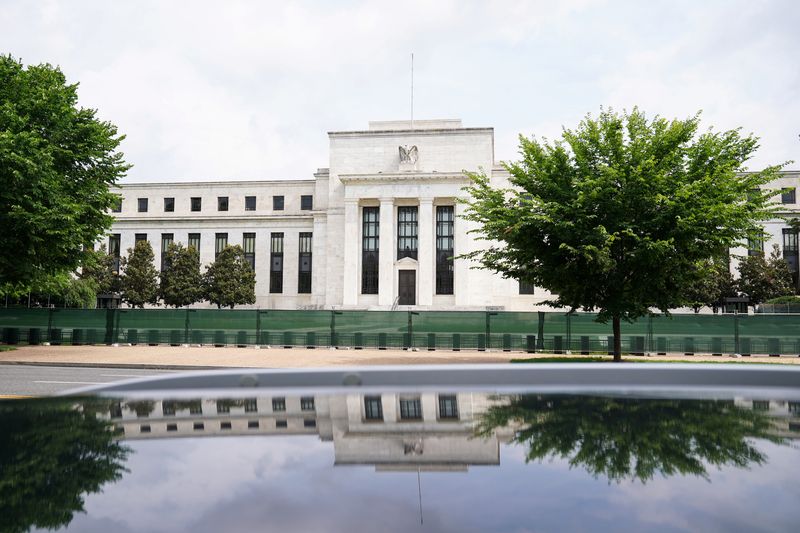By Dan Burns and Ann Saphir
WASHINGTON (Reuters) - Federal Reserve officials agreed they needed to raise interest rates to a more restrictive level - and then maintain them there for some time - to meet their goal of lowering "broad-based and unacceptably high" inflation, a readout of last month's policy meeting showed on Wednesday.
Many U.S. central bank officials "emphasized the cost of taking too little action to bring down inflation likely outweighed the cost of taking too much action," the minutes of the Sept. 20-21 meeting said, with many of them also stressing the importance of staying the course on the inflation fight "even as the labor market slowed."
At last month's meeting Fed officials raised interest rates by three-quarters of a percentage point for the third straight time in an effort to drive inflation down from 40-year highs, and Fed Chair Jerome Powell vowed afterward that they would "keep at it until we're confident the job is done."
That said, the minutes also contained a hint of a downshift in the pace of future monetary tightening, with several policymakers saying it would be important to "calibrate" the pace of further rate hikes to reduce the risk of "significant adverse effects" on the economy.
"Nothing indicates a departure" from the view, expressed in Fed policymaker forecasts, that another 75-basis-point rate hike is likely coming next month, with a further half-percentage-point hike in December, wrote Gregory Daco, chief economist at EY-Parthenon. "Still, there is an increasingly perceptible desire to taper the pace of rate hikes in the context of elevated global economic and financial market uncertainty in the midst of a globally synchronized, but uncoordinated tightening of monetary policy."
Since last month's meeting, policymakers have been united in emphasizing the urgent need to address inflation, which they fear risks becoming embedded, even if their aggressive policy tightening comes at a cost of higher unemployment.
The minutes underscored that view. Several policymakers, the minutes said, "underlined the need to maintain a restrictive stance for as long as necessary, with a couple of these participants stressing that historical experience demonstrated the danger of prematurely ending periods of tight monetary policy designed to bring down inflation."
At the same time "several" policymakers also nodded to the eventual need to ease up, noting "that as policy moved into restrictive territory, risks would become more two-sided, reflecting the emergence of the downside risk that the cumulative restraint in aggregate demand would exceed what was required to bring inflation back to 2%."
Among those several were a few that thought the downside risk was heightened by the potential headwinds from tighter monetary policy and weaker growth globally.
Fed Vice Chair Lael Brainard earlier this week appeared to take a bit of that view on board, making no bones about the need to drive rates high enough and keep them there for long enough to bring down inflation, leavened with some caution around rising risks as other global central banks raise rates.
"They've been talking about how they're willing to risk a recession in order to bring inflation back under control, but its possible that as the recession risks increase they may lose their nerve a little bit," said Chris Zaccarelli, chief investment officer at Independent Advisor Alliance in Charlotte, North Carolina.
TURNING POINT
The last several weeks have marked a turning point for financial markets that for much of the year had clung to a conviction that the Fed would swiftly reverse course next year and cut rates in the face of slowing growth and higher joblessness. Fed officials have pushed back on that expectation, saying they expect to leave rates elevated for some time after they have finished lifting them.
As markets have fully digested the Fed's hawkishness, the result has been crushing losses for U.S. stock markets, rapidly rising yields on government debt and a surging dollar that has aggravated weak conditions in overseas markets.
Policymaker projections released at last month's meeting show the Fed's target policy rate, currently in a range of 3.00%-3.25%, its highest since 2008, rising to the 4.25%-4.50% range by the end of this year and ending 2023 at 4.50%-4.75%. The year-end 2022 projection suggests one more 75-basis-point hike is likely at the central bank's remaining two meetings of the year.
Recent inflation data has shown little to no improvement despite the fastest pace of rate hikes in 40 years, and the labor market remains robust with wages increasing solidly as well.

After the release of the minutes on Wednesday, financial markets continued to reflect expectations for the Fed to raise interest rates along the path signaled in policymakers' projections.
But investors are also betting that by late 2023 the Fed will reverse course and begin cutting rates.